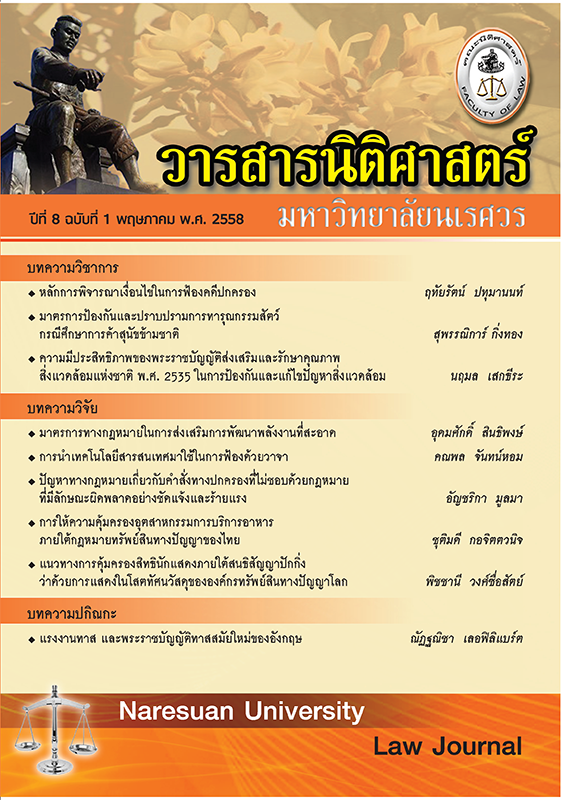Application of Information Technology to Criminal Information Cases
Main Article Content
Abstract
The study focuses on designing an effective type of information technology to criminal information cases in the process of prosecution. At present, some practical problems occur during the criminal information process. Bring information technology to the criminal information procedure can help the process more effective and fairer to parties. For doing this, the Code of Criminal Procedure the Criminal Act on Establishment of District Courts and Criminal Procedure in District Court B.E. 2499 and the Rules of the Office of the Attorney General need to be amended to serve the new information technology system.
Article Details
How to Cite
Chanhom, Kanaphon. “Application of Information Technology to Criminal Information Cases”. Naresuan University Law Journal 8, no. 1 (May 1, 2015): 88–113. accessed December 29, 2025. https://so04.tci-thaijo.org/index.php/lawnujournal/article/view/98733.
Section
Research Articles
References
กาบจันทร์ วรรณสิริวิไล. โครงการพัฒนาระบบสารสนเทศของสำนักงานตำรวจแห่งชาติ POLIS. ม.ป.ท. : ม.ป.พ., 2547.
คณะเทคโนโลยีสารสนเทศ มหาวิทยาลัยเทคโนโลยีพระจอมเกล้าธนบุรี. แผนแม่บทเทคโนโลยีสารสนเทศและการสื่อสาร พ.ศ. 2554-2558 สำนักงานอัยการสูงสุด. ม.ป.ท. : ม.ป.พ., 2553.
น้ำแท้ มีบุญสล้าง. กระบวนการยุติธรรมทางอาญาเปรียบเทียบ. กรุงเทพฯ: สูตรไพศาล, 2554.
วรินทร์ บุณยเกียรติ. ปัจจัยที่ส่งผลต่อผู้นำข้อมูลเข้าระบบฐานข้อมูล POLIS (Police Information System) ของสำนักงานตำรวจแห่งชาติ, 2548.
วิสาร พันธุนะ. “วิธีพิจารณาความอาญาในสหรัฐอเมริกา.” ดุลพาห, 25.
ศูนย์เทคโนโลยีสารสนเทศกลาง สำนักงานตำรวจแห่งชาติ. "ระบบเทคโนโลยีสารสนเทศของศูนย์เทคโนโลยีสารสนเทศกลาง สำนักงานตำรวจแห่งชาติ." แก้ไขล่าสุดเมื่อ 2556. สืบค้นเมื่อ 23 เมษายน 2556. www.pitc.police.go.th.
สรรเสริญ ไกรจิตติ. “ระบบการพิจารณาคดีโดยรวบรัดในศาลอังกฤษ.” ดุลพาห, 1.
Barry Walsh. E-Justice Projects – Distinguishing Myths from Realities. Mexico : The World Bank, 2011.
Hon.Robert J. Faris. “Electronic Filing in the Federal Courts: Past, Present and Future.” Hawaii Bar Journal, 2011.
Inside Government. "Policy Making the criminal justice system more efficient." n.d.. Accessed April 9, 2013. https://www.gov.uk/government/policies/making-the-criminal-justice-system-more-efficient.
Inside Government. "Press release Traffic courts in every area." n.d.. Accessed May 17, 2013. https://www.gov.uk/government/news/traffic-courts-in-every-area.
J. Michael Greenwood and Gary Bockweg. “Insights to Building a Successful E-Filing Case Management Service: U.S. Federal Court Experience” In International Journal For Court Administration, 2012.
John Matthias. E-filing Expansion in State, Local, and Federal courts. N.p.: n.p., 2007.
Legal Aid Agency. "Legal Guidance on Digital Working across the Criminal Justice System." n.d.. Accessed March 13, 2013. https://www.justice.gov.uk/legal-aid/.
Supreme Court of Korea. "Introduction of E-Court." n.d.. Accessed June 20, 2013.
https:// eng.scourt.go.kr/eng/ecourt/introduction.jsp.
United State Courts. "About CM/ECF." n.d.. Accessed April 27, 2013. www.uscourts.gov/ FederalCourts/CMECF/ AboutCMECF.aspx.
United State District Court for the District Court of Maryland. Electronic Filing Requirements and Procedures for Criminal Cases. N.p.: n.p., 2011.
William F. Zieske. “The Electronic Courthouse in Illinois: Filing, Service, Access and Privacy.” Illinois Bar Journal. 2003.
คณะเทคโนโลยีสารสนเทศ มหาวิทยาลัยเทคโนโลยีพระจอมเกล้าธนบุรี. แผนแม่บทเทคโนโลยีสารสนเทศและการสื่อสาร พ.ศ. 2554-2558 สำนักงานอัยการสูงสุด. ม.ป.ท. : ม.ป.พ., 2553.
น้ำแท้ มีบุญสล้าง. กระบวนการยุติธรรมทางอาญาเปรียบเทียบ. กรุงเทพฯ: สูตรไพศาล, 2554.
วรินทร์ บุณยเกียรติ. ปัจจัยที่ส่งผลต่อผู้นำข้อมูลเข้าระบบฐานข้อมูล POLIS (Police Information System) ของสำนักงานตำรวจแห่งชาติ, 2548.
วิสาร พันธุนะ. “วิธีพิจารณาความอาญาในสหรัฐอเมริกา.” ดุลพาห, 25.
ศูนย์เทคโนโลยีสารสนเทศกลาง สำนักงานตำรวจแห่งชาติ. "ระบบเทคโนโลยีสารสนเทศของศูนย์เทคโนโลยีสารสนเทศกลาง สำนักงานตำรวจแห่งชาติ." แก้ไขล่าสุดเมื่อ 2556. สืบค้นเมื่อ 23 เมษายน 2556. www.pitc.police.go.th.
สรรเสริญ ไกรจิตติ. “ระบบการพิจารณาคดีโดยรวบรัดในศาลอังกฤษ.” ดุลพาห, 1.
Barry Walsh. E-Justice Projects – Distinguishing Myths from Realities. Mexico : The World Bank, 2011.
Hon.Robert J. Faris. “Electronic Filing in the Federal Courts: Past, Present and Future.” Hawaii Bar Journal, 2011.
Inside Government. "Policy Making the criminal justice system more efficient." n.d.. Accessed April 9, 2013. https://www.gov.uk/government/policies/making-the-criminal-justice-system-more-efficient.
Inside Government. "Press release Traffic courts in every area." n.d.. Accessed May 17, 2013. https://www.gov.uk/government/news/traffic-courts-in-every-area.
J. Michael Greenwood and Gary Bockweg. “Insights to Building a Successful E-Filing Case Management Service: U.S. Federal Court Experience” In International Journal For Court Administration, 2012.
John Matthias. E-filing Expansion in State, Local, and Federal courts. N.p.: n.p., 2007.
Legal Aid Agency. "Legal Guidance on Digital Working across the Criminal Justice System." n.d.. Accessed March 13, 2013. https://www.justice.gov.uk/legal-aid/.
Supreme Court of Korea. "Introduction of E-Court." n.d.. Accessed June 20, 2013.
https:// eng.scourt.go.kr/eng/ecourt/introduction.jsp.
United State Courts. "About CM/ECF." n.d.. Accessed April 27, 2013. www.uscourts.gov/ FederalCourts/CMECF/ AboutCMECF.aspx.
United State District Court for the District Court of Maryland. Electronic Filing Requirements and Procedures for Criminal Cases. N.p.: n.p., 2011.
William F. Zieske. “The Electronic Courthouse in Illinois: Filing, Service, Access and Privacy.” Illinois Bar Journal. 2003.


